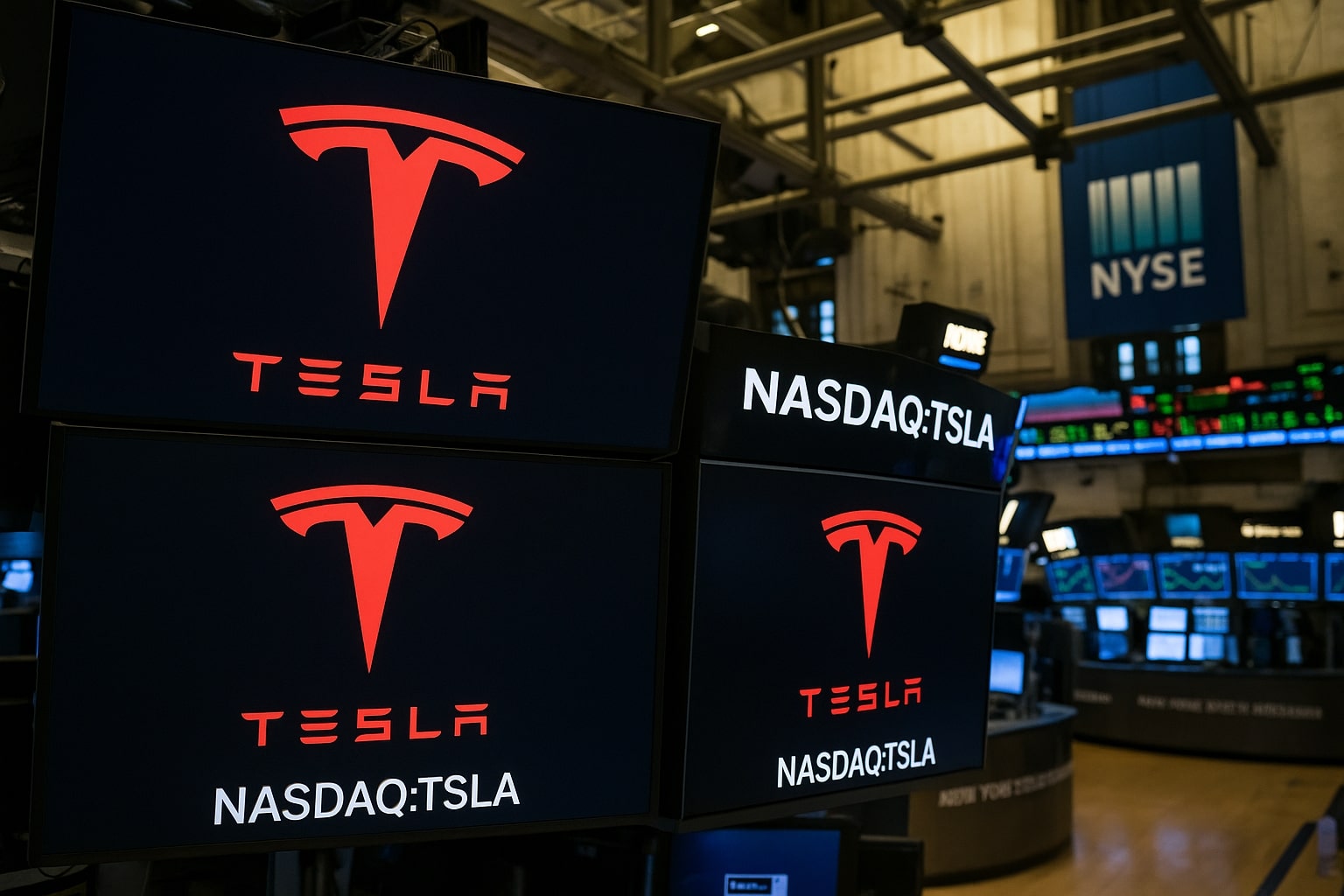
Tesla's Resilient Recovery: Is NASDAQ:TSLA Headed for a $350 Breakout?
Will Tesla’s tech-forward approach and growing energy infrastructure drive NASDAQ:TSLA past the $350 barrier | That's TradingNEWS
Tesla (NASDAQ: TSLA) has experienced a rocky first quarter in 2025, marking a difficult period for its electric vehicle (EV) business, but its long-term outlook still remains promising due to its diversified operations and high-growth segments. The latest numbers from Q1 2025 indicate that Tesla's EV deliveries fell by 13% compared to the same quarter last year, resulting in a 20% drop in auto revenues. Despite these challenges, Tesla's core business remains profitable and stable. In fact, the company’s struggles are largely due to production issues related to the refresh of its Model Y, which caused a temporary production halt in early 2025.
Tesla’s EV Business: Short-Term Struggles and Long-Term Potential
While Q1 2025 was a tough quarter for Tesla's EV business, it’s crucial to focus on the underlying growth trends within the electric vehicle market. Global EV adoption is still in its early stages, and even with a dip in market share, Tesla is positioned to benefit from the broader growth of the industry. Tesla's price-conscious vehicles, which are expected to launch by mid-2025, will likely drive a resurgence in demand as the market for more affordable electric cars expands. The company’s ability to scale production at its existing factories and launch new models at competitive price points will likely rejuvenate its sales figures.
Despite a decline in deliveries, Tesla’s leadership in key markets like California persists, where it remains the top-selling car brand—EV or otherwise. The company’s strong brand recognition, commitment to innovation, and robust production capacity leave it well-positioned to recover in the coming quarters.
Tesla’s Megapack Business: Energy Storage Growth and Competitive Edge
Tesla's energy division, particularly the Megapack business, is growing at an impressive rate, highlighting the company’s shift from being just an electric vehicle manufacturer to becoming an energy infrastructure powerhouse. Tesla’s Megapack deployments surged by 154% year-over-year in Q1 2025, reaching a total of 10.4 GWh. The growth of the energy storage business is not just about increased volume—it’s also about expanding margins. Tesla’s energy division saw gross margins climb to 29% in Q1 2025, up from 25% in Q4 2024.
Despite the skepticism surrounding the energy storage market, Tesla’s ability to consistently expand margins shows that the Megapack business is far from commoditized. Tesla’s competition, including Fluence, has struggled with revenue declines, which further highlights Tesla's strong market position. The company’s storage solutions are essential as renewable energy sources like wind and solar continue to dominate global power grids, which require stable, efficient storage solutions to handle fluctuations in energy supply and demand. Tesla’s Megapack business is not only growing rapidly, but it is also doing so with superior profitability compared to its competitors.
Autonomous Driving and Robotaxi: Tesla’s AI and Robotics Ventures
Tesla’s autonomous vehicle technology continues to set the company apart in the automotive space. As of Q1 2025, Tesla is the only car manufacturer in the U.S. with a full-fledged, generalized artificial intelligence (AI) system capable of self-driving. This positions Tesla as a clear leader in the race to develop autonomous vehicles, especially in comparison to competitors like Waymo (GOOGL) and Zoox (AMZN), whose systems are less generalized and do not offer full autonomy.
Elon Musk’s vision for Tesla extends beyond cars, however. Tesla is rapidly developing autonomous robots through its Optimus division. Optimus robots could revolutionize Tesla’s internal operations by drastically reducing labor costs, while also enhancing the company’s ability to deploy autonomous humanoid robots in the broader economy. While it’s still early in the development of this technology, the potential for Optimus to contribute to Tesla’s future profitability is significant, particularly as the demand for automation across industries grows.
Tesla’s robotaxi program, which is set to launch in Austin, Texas, in mid-2025, has the potential to redefine urban mobility. Tesla’s vast fleet of vehicles, equipped with the latest AI-powered driving technology, positions the company to capitalize on the growing demand for autonomous ride-hailing services. The robotaxi model, once fully operational, could create a new revenue stream for Tesla, as fully autonomous rides become a more viable and scalable option.
Tesla’s Valuation: Strong Technical Momentum, but Overbought Levels
After a dramatic recovery from its April 2025 lows, Tesla stock has surged almost 45%, outperforming the broader market. This rebound has been driven by positive catalysts such as tariff clarity and Elon Musk’s renewed focus on Tesla’s core business. From a technical perspective, Tesla is showing strong momentum, with a “golden cross” pattern forming between its short-term and long-term moving averages. However, the stock is now approaching overbought territory, as evidenced by its relative strength index (RSI), which is nearing the 70 mark.
Tesla’s stock is currently trading at elevated levels, making it more susceptible to a pullback. Its price has surged past key resistance levels, including its 50-day and 200-day moving averages, but with its RSI signaling potential overbought conditions, investors should remain cautious in the near term. A correction could occur if the stock fails to maintain its current momentum. However, if Tesla breaks above $350, it could signal further upside, making the stock worth considering for a long-term position.
Tesla’s Future Growth Catalysts: What to Watch
Looking forward, Tesla’s upcoming affordable EV launch, the continued expansion of its Megapack business, and the rollout of robotaxi services remain key growth catalysts. However, execution risks remain. Tesla’s ability to ramp up production of the lower-priced EV model will be crucial to driving volume growth, and the success of the robotaxi program depends on regulatory approvals and consumer adoption.
Tesla’s energy business, led by the Megapack, continues to show signs of significant growth, with large-scale deployments and increased adoption by utility companies. As the energy transition accelerates globally, Tesla’s energy storage solutions will become even more essential, making this an exciting area to watch for future growth.
Conclusion: Buy, Hold, or Sell?
Tesla's stock has made an impressive recovery, but at current levels, it appears to be overbought in the short term. While the long-term growth story remains intact, with strong growth in both EVs and energy storage, investors should exercise caution. If Tesla’s stock pulls back to more reasonable levels—around the $300 mark or lower—it could present a buying opportunity. The company's diversification into energy storage, robotics, and autonomous vehicles provides significant upside potential, but execution risks and competition remain challenges.
For further insights into Tesla’s performance and insider transactions, visit Tesla’s stock profile.
That's TradingNEWS
Read More
-
BITQ ETF Soars 66.55% as Bitcoin Blasts Past $124,000 — Crypto Equities Lead 2025 Rally
13.10.2025 · TradingNEWS ArchiveStocks
-
XRP ETFs XRPR, XRPI Slip as Ripple XRP-USD Holds $2.62 — SEC Fast-Track Could Ignite $20B
13.10.2025 · TradingNEWS ArchiveCrypto
-
Natural Gas Price Forecast - NG=F Steadies at $3.00 as U.S. Export Boom Tests Old Fields
13.10.2025 · TradingNEWS ArchiveCommodities
-
USD/JPY Price Forecast - Dollar to Yen Climbs to ¥152.28 as Japan’s Political Shakeup
13.10.2025 · TradingNEWS ArchiveForex


















